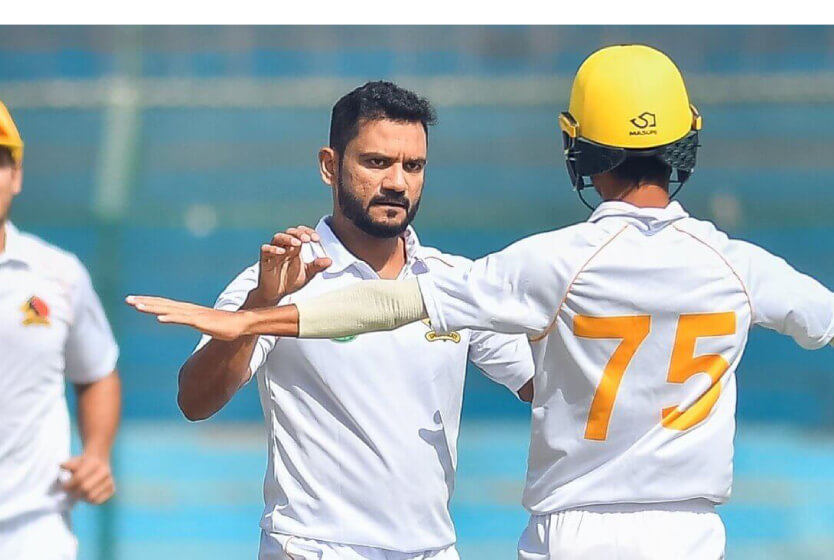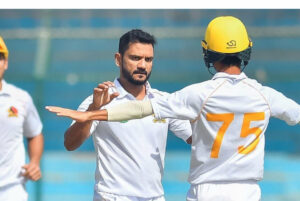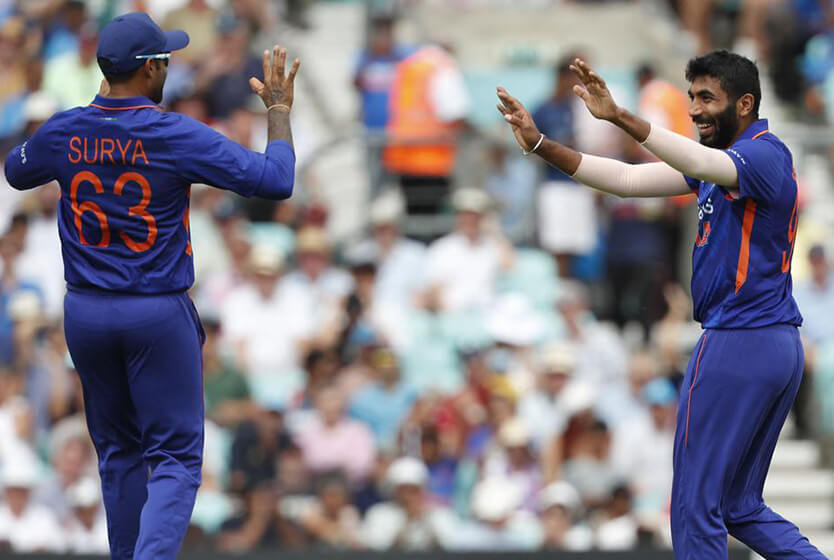
Dissecting Tabish Khan
One hundred and thirty-one first-class matches, five hundred and seventy-eight wickets, thirty-eight five-wicket hauls but ZERO Test caps. How did this happen?
Tabish’s Early Years
Let’s start at the beginning, but for that, we need to assess what was the beginning. Was it his first-class debut in the Quaid-e-Azam (QeA) Trophy season of 2002/03 at the age of 18?
Up until the start of the 2008/09 season of the QeA Trophy, Tabish had played 8 matches over the space of 6 years, in which he had 24 wickets at an average of 41.9. His story was in danger of finishing before it really began.
In the 2008/09 season of the QeA Trophy, Tabish Khan, at 24 years old, finished as the 13th highest wicket-taker with 39 wickets at an average of 26.23. He had successfully salvaged his career and put his name on the board as one to watch. Others above him on the wicket-takers’ list included domestic veterans like Abdur Rauf (53 wickets at 15.5), Samiullah Khan (40 wickets at 20.5), and future international star Mohammad Amir (55 wickets at 15.1).
Side note: It is widely believed that one amazing domestic season is not enough to earn national selection; you are required to churn out consistent performances every season for a period of two to three years.
Knowing this, Tabish came back in the 2009/10 season of the QeA Trophy, with his place in the side now assured, and proceeded to finish as the 6th highest wicket-taker with 61 wickets at an average of 22.8. He would also play for “The Rest” in the RBS Pentangular Cup, taking 16 wickets at an average of 29.1. The average may have been a bit on the higher side, but the momentum was building; one more good season, with age on his side, his case would be near irrefutable.
In the 2010/11 season of the QeA Trophy, Tabish Khan played only six matches. He finished at number 41 of the highest wicket-takers’ list, with 28 wickets at 26.39 in a season where other top fast bowlers averaged 15–20. The momentum vanished into thin air.
Tabish’s team was demoted to Quaid-e-Azam Trophy Division Two in 2011/12. He would end up as the highest wicket-taker of the season with 61 wickets at an average of 15.5, but he had done it while playing second division cricket. County cricketers have faced a similar issue playing for the lower counties; they perform in second division cricket, but their team cannot make the step up, and they get ignored for national selection. But Tabish had the opportunity to make the step up; the PCB organized the Faysal Bank Pentangular Cup 2011/12, where the best cricketers from each province were pitted against each other. Tabish played all of Sindh’s matches, took 16 wickets but ended up with a bowling average of 36.6; other fast bowlers averaged 20–30.
How the Haphazard Domestic Structure Played a Role
Over here, I feel the need to take a detour to give a quick background to the uninitiated, the quagmire that is the Pakistan first-class domestic system pre-2019. There were two types of teams, regional and departmental. Regional, as the name suggests, consisted of players from that region. However, departmental teams were not restricted by region; they could contract any player they thought would add value to their team. This resulted in the departmental teams often being very strong, and regional teams would be the perennial whipping boys; whoever would perform for regional teams would eventually be signed by a departmental team.
In 2012/13, the PCB tried to address this issue by once again changing the first-class structure. The regional teams and departmental teams were divided. The regional teams would now participate in the QeA Trophy. In contrast, the departmental teams would play against each other in the President’s Trophy.
Tabish’s team was the Karachi Blues, a regional team. He finished as the 4th highest wicket-taker in the QeA Trophy. Still, it did nothing to alleviate the perception that he is a big fish in a small pond who struggles on the step-up (see his QeA division one and Pentangular Cup numbers). That the selectors perhaps didn’t give much importance to the QeA Trophy 2012/13 may be because the top 20 wicket-takers had 8 Test caps combined at the time (7 for Aizaz Cheema and 1 for Rao Iftikhar Anjum).
However, the President’s Trophy 2012/13 saw 19-year-old Ehsan Adil, coming off an impressive U19 WC, become the 2nd highest wicket-taker. This earned him a call up to the Pakistan Test squad to South Africa. Rahat Ali had 90 wickets at an average of 17.8 since 2010 in the QeA Trophy, but only when he picked up 27 wickets at 24.78 in the President’s Trophy was he selected for the Pakistan squad.
So it was now clear that the QeA Trophy was no longer Pakistan’s premier first-class competition; the President’s Trophy was. The selectors may have dismissed Tabish’s consistent performances, but they caught the eye of the Sui Southern Gas Corporation’s talent scouts. At long last, Tabish would play for a departmental team; he would play the President’s Trophy. And play he did, he finished as the 5th highest wicket-taker with 47 wickets at 24.7 in the President’s Trophy 2013/14. The momentum was back!
The PCB would change the domestic structure the next year, back to the old QeA Trophy format with divisions. Except, instead of being called division one and two, they were called QeA Trophy Gold and Silver.
As you can guess, seeing Tabish’s luck so far, his team in 2014/15 was in QeA Trophy Silver. He was the 2nd highest wicket-taker with 42 wickets at an average of 19.7. Even though it was the Silver Trophy, the momentum had reached a breaking point. He was rewarded with a national call-up… for the Pakistan A side.
In 2015, Pakistan A toured Sri Lanka for three one-day matches and three four-day games. Tabish’s returns for his FC team were three wickets at an average of 86 and SR of 144. He had once again struggled on the step up. It just reinforced the big fish in a small pond perception, with his Silver Trophy numbers retroactively hurting him.
The PCB would once again change the domestic structure, doing away with the divisions. In the 2015/16 QeA Trophy, Tabish ended up 27th on the wicket-taking charts with 25 wickets at 27.6 while other fast bowlers averaged 15–22. At 31 years old, he found himself without a departmental contract and returned to his regional team, Karachi Whites.
He would pull himself by his bootstraps next QeA Trophy season and finish as the second-highest wicket-taker with 62 wickets at 13.55, only to be pipped for national selection by the highest wicket-taker of the season, Mohammad Abbas (71 wickets at 12.75), who was five years younger than Tabish. The pacers that made the 2017 tour of West Indies were Mohammad Abbas, Mohammad Amir, Hasan Ali, and Wahab Riaz. A successful tour meant the same combination was picked for when Sri Lanka visited the UAE. Tabish had found himself in the Mickey Era of backing young talent with even more emphasis on pace. Meanwhile, his impressive show in the QeA Trophy earned him a contract with PTV.
The next two seasons with PTV would see him finish as 14th and 20th highest wicket-taker – respectable but not screaming national call-up. Once again, the FC structure changed in 2019/20, with flatter pitches and the Kookaburra ball seeing him take 25 wickets at a high average of 40.9.
Factors Leading To Non-Selection
Late Bloomer
As mentioned above, Tabish only really started performing at a national level consistently in 2008. The first six years of his career were spent in the wilderness. It is those six years lost that may have ultimately cost him a chance at an international career. Now obviously, would Tabish been the same bowler he is today if he didn’t spend those years barely playing the game? One cannot say.
Pace is Pace Yaar
Right-arm medium-pacers are a dime a dozen, not only in Pakistan but around the world. With its rich history of fast-bowling, Pakistan has never really rated medium-pacers; Hassan Cheema told us as much in the recent episode of TCL Sports Lounge. Medium pacers have often been treated, in his words, “as second-class citizens.” Abdur Rauf, Fazl-e-Akbar, Tabish Khan, Sajid Shah, Aizaz Cheema, Rao Iftikhar Anjum, and Tahir Mughal are all right-arm medium-pacers with 500+ first-class wickets. However, they have only 16 Test caps between them.
Note: Mohammad Abbas debuted in the 2008/09 season; like Tabish, he too took time to bloom, but he had time on his side. Abbas benefited from always playing division one cricket, thus never falling for the big fish small pond trap. But until 2014/15, his record was mediocre. However, his rise after that was rapid. In 2015/16, he was the highest wicket-taker. In 2016/17, he was once again the highest wicket-taker. From 2014–17, he played 28 matches in which he took 170 wickets at an average of 16.2. He was selected for the Test squad in 2017. It took him being 27 years old and averaging 16.2 for three seasons that finally convinced the Pakistan selectors to select a right-arm medium-pacer.
Format Mixing
While Tabish’s FC record will rival the top bowlers globally, his limited-overs record leaves much to be desired. That is most probably because limited-over matches in Pakistan are played on flatter pitches, where Tabish’s friendly pace means it’s easy to hit him across the line. Selection for the longer format of the game should be made on FC numbers, but selectors have often been guilty of mixing formats. A prime example of this was when Tabish toured Sri Lanka with the A side. He was in no way among the best List A bowlers in the country, but he still played the matches and predictably went for 7.25 runs per over. It most likely hurt the management’s perception of him and was probably why he didn’t play the first four-day game in the series.
Victim or Benefactor?
Pakistan’s first-class pitches before 2019 assisted fast bowlers a great deal. Low scores were very common, and bowlers finishing the season with averages under 20 was considered normal. To say that conditions benefited Tabish’s type of bowling would be an understatement. Tabish was one of many who reigned supreme. It becomes difficult to separate the cream from the crop. It didn’t help that the first-class system would be changed almost every two years, making the pathway to the national team cloudy. Furthermore, it didn’t help that Tabish’s region would often play second division cricket. The departments took so long to identify and sign him because of the other three factors mentioned. Would Tabish Khan have 578 first-class wickets if the system was different? Probably not, but he may have had a Test cap. And ultimately, he would probably exchange all 578 FC wickets for one Test cap.







Leave a Reply